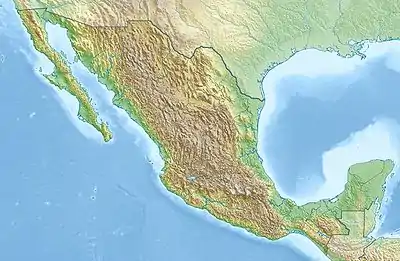 | |
| UTC time | 1912-11-19 13:55:03 |
|---|---|
| ISC event | 16958218 |
| USGS-ANSS | ComCat |
| Local date | 19 November 1912 |
| Local time | 07:55 |
| Magnitude | 6.7–6.9 Mw |
| Depth | 15 km (9.3 mi) |
| Epicenter | 19°33′40″N 99°53′02″W / 19.561°N 99.884°W[1] |
| Type | Normal |
| Max. intensity | X (Extreme) |
| Aftershocks | 60 |
| Casualties | 140–161 killed |
The 1912 Acambay earthquake struck the State of Mexico on 19 November at 07:55 local time.[1] It had a moment magnitude of 6.7–6.9 Mw and an epicenter near the town of Acambay, 80 km (50 mi) northwest of Mexico City. Up to 161 people died and there was severe destruction. It is regarded as one of the most important earthquakes in Mexico's seismological history, having been widely studied.
Tectonic setting
The Trans-Mexican Volcanic Belt which spans across central Mexico for 1,000 km (620 mi) is the product of ongoing subduction of the Cocos and Rivera plates beneath the North American Plate. These plates subduct off Mexico's Pacific coast and plunge about 120 km (75 mi) beneath the volcanic belt. Seismicity occur along the subducting plates. However, the volcanic belt also produces shallow intraplate earthquakes along faults within. Although these earthquakes are rare, they can measure up to Mw 7.6 and be destructive. Most of these earthquakes are due to normal faulting while small components of strike-slip have been determined through seismic inversion.[2]
Earthquake
Only two major earthquakes of the Trans-Mexican Volcanic Belt have been instrumentally recorded; the 1912 Acambay and 1920 Xalapa earthquakes. Located just northwest of Mexico City, the 1912 earthquake is regarded as the closest shallow intraplate earthquake to the city. The geology of the city, consisting of soft clay deposits from an ancient lake, arriving seismic waves are amplified, causing large ground motions. The estimated Modified Mercalli intensity in the city was VII–VIII.[2]
The earthquake ruptured the Acambay-Tixmadejé Fault, a north-bounding fault of the Acambay graben. It is a normal fault that dips 60–70° to the south. The east–west trending graben measures 80 km (50 mi) long and 15–40 km (9.3–24.9 mi) wide, bounded to the north and south by faults.[2] A 36 km (22 mi)-long surface rupture was observed with a fault scarp of ≥50 cm (20 in). Rupturing was also reported along faults within the graben and the opposite-bounding Pastores Fault for 10 km (6.2 mi) and 17 km (11 mi), respectively. Surface ruptures were well documented and photographed by geologists.[3] About 60 aftershocks were recorded from 19 November 1912 to 15 April 1913.[4]
Impact
Between 140 and 161 people were killed in Acambay, Timilpan and Tixmadejé. Victims perished during the collapse of colonial-era buildings. Brick, adobe baroque-style structures were destroyed. In Acambay, every home was destroyed and a church toppled during a mass.[5] Mexico City was damaged. Many historical structures were destroyed. Reconstruction of the affected communities began in 1913.[4] A maximum seismic intensity of X was assigned in Acambay and Tixmadejé.[6]
See also
References
- 1 2 ISC-GEM Global Instrumental Earthquake Catalogue (1900–2009), Version 9.1, International Seismological Centre, 27 June 2022
- 1 2 3 Suárez, Gerardo; Caballero‐Jiménez, Gema V.; Novelo‐Casanova, David A. (30 August 2019). "Active Crustal Deformation in the Trans‐Mexican Volcanic Belt as Evidenced by Historical Earthquakes During the Last 450 Years". Tectonics. 38 (10): 3544–3562. Bibcode:2019Tecto..38.3544S. doi:10.1029/2019TC005601. S2CID 202923598 – via John Wiley & Sons.
- ↑ Langridge, Robert Max; Weldon II, Ray J.; Moya, Juan Carlos; Suárez, Gerardo (2000). "Paleoseismology of the 1912 Acambay earthquake and the Acambay-Tixmadejé fault, Trans-Mexican Volcanic Belt". Journal of Geophysical Research: Solid Earth. 105 (B2): 3019–3037. Bibcode:2000JGR...105.3019L. doi:10.1029/1999JB900239.
- 1 2 National Seismological Service. "Historical Earthquakes Earthquake of 1912 in Acambay, Edo. of Mex. (M~6.9)" [Sismos Históricos Sismo de 1912 en Acambay, Edo. de Mex. (M~6.9)] (PDF). Retrieved 14 September 2022.
- ↑ "A 108 años del sismo de Acambay" [108 years after the Acambay earthquake]. Government of Mexico (in Spanish). 19 November 2020. Retrieved 14 September 2022.
- ↑ Rodríguez-Pascua, M.A.; Pérez-López, R.; Garduño-Monroy, V.H.; Perucha, M.A.; Israde-Alcántara, I. (2017). "Estimation of the epicentral area of the 1912 Acambay earthquake (M 6.9, Mexico) determined from the earthquake archaeological effects (EAE) and the ESI07 macroseismic scale". Quaternary International. 451: 74–86. Bibcode:2017QuInt.451...74R. doi:10.1016/j.quaint.2017.06.045. hdl:10261/277155.